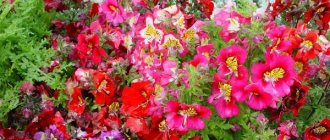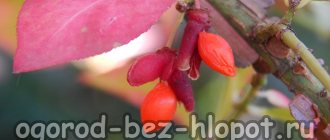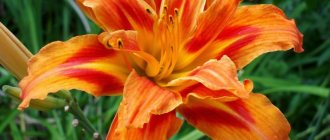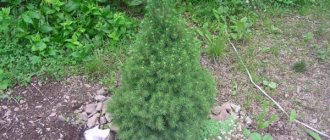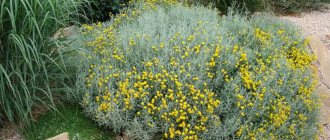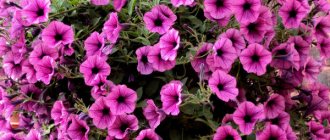Kniphofia is an exotic evergreen plant with a large, spike-shaped or plume-shaped inflorescence. The flower has interesting features, for example, the buds change the shade of the petals throughout the season from red to orange and lemon.
In which regions is African Beauty grown? Is Kniphofia capricious? Planting and care in open ground is no more difficult than when growing other exotic plants on the site. All the nuances of growing the original species are revealed in the article.
Growing from seeds to seedlings
In the second decade of March or early April, it is time to sow planting material. The seeds must have a suitable shelf life. For hybrid varieties, it is advisable to buy planting material from a trusted agricultural store to avoid planting expired elements.
Soil and container
To germinate seeds, you need a wide and not very deep wooden box or container. I put drainage at the bottom, for example, expanded clay or pebbles, then pour in a nutritious, but always light, substrate containing humus, peat, sand.
Planting material is not buried in the soil, but simply placed on the surface of the substrate. Next, the seeds are lightly sprinkled with slightly moistened soil, water is sprayed from a spray bottle, and the container is covered with thick film or glass to maintain the “high humidity” mode. In such conditions, an optimal microclimate is created for the germination of African plant seeds.
To speed up germination, it is useful to treat the planting material with Fitosporin or Kornevin. The working solution is prepared according to the recommendations on the package. It is important to adhere to the timing of soaking the seeds so as not to harm the planting material.
Temperature and lighting
While the “black earth” period lasts, the mini-greenhouse should be covered with glass.
It is important that the container is located in an area with good lighting, not in a draft. Suitable room temperature is about +22 degrees. You can place the container on the windowsill, but you need to make sure that the sun in the southern regions does not fall on the ground all day. On a note! A couple of times during the germination period you need to remove the glass or film, wash off the condensation, and spray the substrate if necessary. To prevent mold from appearing, before placing it in a container, the soil is watered with potassium permanganate (always a strong solution) or calcined in the oven.
Seedling care
After germination, it is important to follow the rules:
- Water the seedlings as needed, making sure that the substrate is not dry. You should not overwater the young shoots of Kniphofia: the African plant does not tolerate waterlogged soil, rotting begins, and the “black leg” disease develops. Moderate watering is carried out along the edge of the container and under each seedling, making sure that the moisture does not remain on the leaves for a long time;
- seedlings are germinated in a lighted place. The same rule applies as when growing other species: seedlings should not be kept in a cold, dark or shaded place. In low light conditions, the sprouts stretch out, weaken, become fragile, and get sick;
- Kniphofia seedlings after emergence are grown at a temperature of about +18..+20°C. Too high rates interfere with the gradual strengthening of seedlings; the sprouts quickly stretch out and are ready for transplanting into open ground earlier than weather conditions allow. Overstayed, elongated seedlings are always more frail than seedlings grown in compliance with the deadlines and rules.
Transplanting
The picking is carried out when three true leaves are thrown out. It is important that before planting sprouts in open ground, the seedlings are accustomed to the action of fresh air. First, open the film for half an hour, then for a longer period. Before planting, the seedlings spend the night outside if the air is well warmed up and the temperature does not drop below +14 degrees.
The complete absence of return frosts, good heating of the soil is a prerequisite for moving seedlings into the soil without fear for the further condition of the “African beauty” Kniphofia.
Holes are dug in the soil depending on the size of the plant. At the bottom of the recess you need a layer of sand or expanded clay: this way it is easier to ensure a good outflow of water and prevent rotting of the roots. A mixture of three components (humus, peat and sand) is poured over the drainage, then strengthened and hardened seedlings are planted.
Knifofia wintering
In different climatic zones, wintering of kniphofia is organized differently. In the south, it is able to winter in open ground conditions only if there is shelter. They begin to prepare it in the fall, tying the foliage so that moisture cannot penetrate into the rosettes, and sprinkling it with leaves.
It is possible to use spruce branches and film insulation, but in the latter case, holes must be made for ventilation, although sometimes they are limited to simply loosely pressing the film to the ground surface to form gaps. These measures will increase the plant's tolerance to frost to -15℃.
In the north, under no circumstances should kniphofia be left outdoors in the winter - it is dug up, placed in a container with a nutrient substrate and a good layer of drainage, then transferred indoors. The temperature during the winter in this case is maintained at +8 ℃. Replanting is carried out upon the onset of warm weather, when the threat of return frosts has completely passed.
Planting seeds in open ground
The plant, originally from Africa, should not be grown from seeds without seedlings. Even in warm regions, Knifofia will not have time to grow sufficiently and bloom in due time. The best option is to grow seedlings, which, after hardening, are transplanted to the site to create a decorative composition.
Choice of location and lighting
The African plant naturally grows in open areas. Similar conditions will have to be created in the garden or lawn. Lack of light interferes with normal growth and release of inflorescences. Kniphofia should not be planted under trees, near buildings, next to canopies and any structures that provide shade.
Other important criteria when choosing the optimal location area:
- not a wetland;
- not in the lowlands;
- open area on a hill or flat area;
- absence of strong winds and drafts;
- not heavy, necessarily loose, soil;
- good drainage of water from the site.
Soil requirements:
- a mixture of nutritious, light earth and sand;
- good aeration and permeability of the soil.
Features of growing ornamental crops
The origin of the plant dictates its own laws - for a favorable growing season and confident flowering, most varieties require a hot climate with sunny weather and short, mild winters. In the northern regions and central part of Russia, only one variety of perennial is more often planted - Kniphofia Tukka.
It is better to grow exotic flowers in areas where the sun reigns most of the day - elevated areas, southern slopes. To make the plant bloom longer, only light partial shade is allowed. When determining the planting site, drafts should be excluded.
It is best to plant kniphofia in places open to sunlight and near water bodies.
Due to the fact that kniphofia is a rather tall plant, it is better to use it in the middle of flower arrangements. And the brightness of the coloring of this African exotic recommends a competent approach to the formation of a flower bed - next to the perennial it is better to place squat representatives of the flora with discreet flowers and an abundance of greenery.
Under natural growing conditions, kniphofia happily settles in places with high humidity - near swamps and ponds . In landscape design, you can use this natural “love” for water and plant a flower next to artificial ponds in your garden plot.
Outdoor care
If the rules are followed, the African plant Kniphofia takes root well even in temperate latitudes. For beginning flower growers and anyone who is not yet familiar with this interesting perennial, here are recommendations for caring for and carrying out basic agricultural activities.
Watering
The drought-resistant species does not tolerate waterlogging of the soil and excessive moisture during all periods of development. Even during flowering, water is added in moderation as the soil dries. It is useful to let the liquid from the tap sit for one to two days before watering.
Feeding and fertilizer
On a note:
- The application of nitrogen-based mineral compounds is carried out in the spring to stimulate active vegetation.
- A couple of weeks after the first feeding, organic components are added to the soil: peat, compost, high-quality humus.
- During the flowering period, compounds with potassium and phosphorus are added every two weeks so that the inflorescences are strong and large.
- If the plant overwinters in the ground, then it is advisable to add ash to receive a portion of nutrients and better adapt to the effects of cold.
Care during and after flowering
What to do:
- apply mineral fertilizers with a high content of potassium and phosphorus (3:1) for active release of buds and a long season of bright colors;
- water the plant on time. Even such a drought-resistant species as Kniphofia blooms worse when there is a lack of moisture. You cannot flood the plant: the gardener must always remember this;
- check the inflorescences, make sure that there are not many faded buds on the ear;
- It is not practical to collect seeds from hybrid varieties.
Bush formation
Hygienic pruning is performed in early spring, after removing the protective layer from the area where Knifofia overwintered. Be sure to cut off rotten, broken branches and remove all diseased areas.
Mulching, loosening
Helpful Tips:
- the African plant loves warm soil and warmth. For this reason, experienced gardeners advise mulching the soil around the bushes with pebbles or pebbles of different sizes (medium and small), and pouring peat mulch on top. Dark natural material attracts sunlight, which improves the flow of heat into the soil. Mulching is carried out throughout the season, especially in cool times. On hot days, the layer of mulch should be thinner, and as the temperature drops, thicker;
- under a layer of pebbles and peat, weeds reproduce inactively. Weeding is carried out at an early stage of growing Kniphofia, while the seedlings are young. It is important to remove weeds while the seedlings are taking root in the soil, so that pest plants do not interfere with the development of a beautifully flowering species;
- loosening. If there is no layer of peat and pebbles on the ground, then you need to loosen the soil in a timely manner so that there is no dense crust on the surface. The procedure is carried out on slightly moist soil, and weeds are removed at the same time. Loosening is a mandatory event during the growth of young Kniphofia.
2.When does kniphofia bloom?
The flowering period begins in May - June and lasts a very long time. Tubular buds, opening sequentially - from the base of the inflorescences to their tops, prolong the flowering time.
Some varieties are able to bloom in August and September. With timely pruning of flower stalks with wilted buds in the summer months, re-blooming in the fall is possible, although it will be less abundant. Often such flowering is interrupted by frost.
↑ Up,
Protection from pests and diseases
Parasitic insects and mites attack weakened plants if the African species is not properly cared for. Pests can settle on leaves and buds if there are other garden plants, berry bushes and fruit trees nearby where leaf-eating parasites live.
What to do:
- When identifying thrips and aphids, insecticides are used; acaricides are needed to destroy spider mites.
- The treatment is carried out in long sleeves, wearing a respirator and plastic goggles. Hands must be protected with rubber gloves.
- For prevention, experienced flower growers advise spraying Kniphofia bushes four to five times a season with decoctions and tinctures based on natural ingredients: garlic, onion peels, pyrethrum flowers, tobacco leaves.
Important details:
- The plant rarely gets sick, most often root rot develops - a problem associated with excessive watering. In case of severe blackening of the stem, wilting of the leaves, or the appearance of a grayish-white and black coating, the affected plants are removed from the soil.
- If the disease is in the initial stage, the affected area is small, then treatment with fungicides (powerful antifungal drugs) will help. Chemical and biological agents have a good effect.
- Fungicides are applied not only to the plant, but also to water the soil. It is important to prepare the working solution correctly so that the product has the optimal concentration. Repeated processing is often necessary to consolidate the effect.
- Work with fungicides is carried out in compliance with the same rules for protecting the body as when spraying and using the liquid form of acaricides and insecticides.
Description of the plant
Garden kniphophia, also called kniphofia, belongs to the Asphodelaceae family. There is also a classification where the species is included in the Xanthorrhoeaceae family. Depending on the species, the plant grows up to 180 cm. The spike-shaped inflorescences look very exotic, they are distinguished by a gradient color - the top turns into a shade of dark red, and the flowers below are yellow or yellow-green.
Because the inflorescences have a characteristic vertical shape, most of the time they appear as bicolor (yellow-red) torches of flame.
The name Kniphofia comes from the name of the German physician and botanist J. Kniphof.
Knipphochias are pollinated by birds - nectaries. Flowers can be a trap for bees - their narrow petals cause insects to get stuck in them.
Botanical description of the plant:
- Form. Perennials with thick or thin rhizomes growing horizontally from which tufts of leaves emerge. Plants are usually stemless, but stem kniphophia has a stem and reaches a height of 30 cm.
- The underground part of the perennial consists of rhizomes and fleshy roots.
- The leaves are numerous, narrow, form a basal rosette, sometimes double-rowed, usually arched. The leaf blades are evenly narrow, have a V-shaped cross-section, entire or with fine teeth. They reach a length of 100-120 cm, the color is light green, bluish.
- Flowers – small, collected in tall (60-180 cm), usually unbranched (sometimes with short branches), dense spike-shaped inflorescences. Under the inflorescence there are 1-3 small bracts. The flowers are sessile or short-stemmed and develop sequentially from bottom to top, creating the so-called ombre effect. Initially (in the bud) they are located horizontally, over time they hang down and become lighter. As a result, the inflorescences are usually two-colored - red on top, transitioning to a yellow tint, and white at the bottom. Rarely are the inflorescences uniform in color along the entire length - red or yellow-green. The perianth consists of 6 leaflets fused into a long tube or funnel, with 6 spots of different sizes at the end. There are 6 stamens. The superior ovary is three-lobed. The inflorescence blooms for several weeks.
- Fruit - round or ovoid capsules, triangular in shape with seeds that are flattened, triangular or sometimes winged.
Reproduction
The simplest method is to divide the bush. Even novice gardeners can carry out vegetative propagation of African flowers. Unlike growing an exotic species from seeds, flowering in young Kniphofia, obtained by dividing an adult plant, begins this year.
Dividing the bush
How to proceed:
- after three years, children or daughter rosettes are formed on the adult Kniphofia. These elements are used for breeding the African species on the site using the vegetative method;
- The children are separated from the mother bush with a sharp knife, and the media are certainly sprinkled with crushed coal;
- The rosettes are dried for two to three hours, then planted in holes, at the bottom of which there is drainage and a nutrient substrate is filled. After planting, the soil is compacted a little and watered;
- for the first time, the young seedling is slightly shaded, but without diffused color, rooting and vegetation are inactive;
- At first, water abundantly, but without waterlogging. When Kniphofia takes root well, the level of substrate moisture is brought closer to normal: moderate watering is needed.
Seeds
Seeds for growing Kniphofia are almost never sown in open ground: the African species does not produce planting material well that has the ability to ripen in temperate latitudes. Another point is the failure to preserve parental characteristics when growing hybrids from seeds collected on the site independently. Even in the southern regions, the seedling method is used to propagate an exotic species with unusual inflorescences. With the right approach to growing seedlings, the seedlings take root well in open ground, and in the third year after planting you will be pleased with the spectacular inflorescences.
Types and varieties of kniphofia with photos and names
A relatively small number of Kniphofia species are cultivated in Europe.
Kniphofia tuckii
This species is native to the southern part of the African continent. It was discovered in 1892, and it was discovered by a scientist, after whom this species is named. The height of the bush is about 0.8 m. The length of the greenish leaf plates is up to 0.4 m, they have a sword-shaped shape. The inflorescences, reaching a length of 15 centimeters, consist of red-yellow flowers, while the buds are colored reddish. Kniphofia Taka differs from other species in its highest resistance. In this regard, this species has gained great popularity among gardeners in mid-latitudes, since the bushes can be left in the ground for the winter, but provided that they are well covered.
Kniphofia uvaria
In nature, this species can only be found in the Cape Province. The height of the vigorous bush is about 200 cm. The length of the green-gray leaf plates is about 50 cm, they have a sword-shaped shape. Large inflorescences reach 0.25 m in length, their lower flowers are yellow-green, and the upper ones are red-coral. This plant blooms for about 8 weeks. It has been cultivated since 1707. Varieties and forms:
- Large-flowered form . The height of the bush is about 1.3 m. The length of the inflorescences is up to 0.3 m, they consist of fiery red flowers.
- Dr. Kerr . Peduncles reach a meter in length. The height of the inflorescences is about 20 centimeters, they consist of lemon-yellow flowers.
- Orange Beauty . The length of the peduncles is approximately 100 centimeters. Orange flowers are collected in inflorescences.
- Fire Flame . The flowers are painted scarlet-red.
- Eskimo . The bushes reach a meter in height. The flowers located below are yellow in this variety, while the upper ones can be painted in various shades from red-coral to orange.
Hybrid Kniphofia (Kniphofia x hybrida)
Here are collected all the varieties and hybrids that were created using Kniphofia berry. Popular hybrids and varieties:
- Abendzonne . Peduncles, reaching a height of 1.2 m, consist of lower yellow flowers and upper red ones.
- Cardinal . The bush reaches a height of 1.2 meters. The flowers are painted fiery red.
- Bernox Triumph . The height of the low bushes is about 0.6 m. The color of the flowers is deep orange.
- Golden Skepter . The height of the peduncles is about 1.2 m. The large inflorescences include flowers of a rich yellow color.
- Indiana . The height of the plant does not exceed 100 centimeters, it is decorated with red-orange flowers.
- Royal Standard . This variety was born earlier than the others, but to this day it is very popular. The height of the bush is about 100 cm, the inflorescence consists of upper scarlet-red flowers and lower ones - yellow.
- Prince Maurito . The bush, reaching a height of 1.2 m, is decorated with large red-brown inflorescences.
- Theo . The height of the plant is about 100 cm, it blooms profusely. The color of the inflorescences is red-orange.
- Rocket . Large red-cinnabar inflorescences are located on peduncles reaching 1.3 m in length.
- Kniphofia hybrida Fleming Torch . The bushes are low, about 0.6 m, they are decorated with yellow-red inflorescences.
KNIPHOPHIA IS A DECORATIVE PERENNIAL.
Autumn care and wintering
The African species tolerates the cold period well if the plant is properly prepared:
- leaves from the root rosette are carefully tied to block the access of moisture to the central rosette;
- you can insulate the bush with film, after making holes for ventilation;
- Be sure to sprinkle the bush with fallen leaves or cover it with spruce branches;
- with a sufficient thickness of the protective layer and proper shelter, the African plant can withstand cold temperatures down to -10°C, which is rare in the southern regions.
In middle and northern latitudes, you should not leave the bush in the ground: the plant freezes. Kniphofia is carefully dug up and planted in a flowerpot with a drainage layer, high-quality soil, and good soil aeration. For wintering, a period of rest is organized. The bush is located in a cool room, where there is no bright lighting and high temperature: +8..+10 degrees is enough, no more.
Fertilizer for kniphofia
Regular feeding will help increase the volume of flowering and stimulate growth.
In early spring, you should feed with complex fertilizers, and before planting you need to add organic matter (in the future, adding it will also not be superfluous - every year in the spring). As soon as flowering ends, add potash fertilizers or ash.
Knifofia in landscape design
"African Beauty" successfully plays the role of the first violin on the lawn, sunny area or in the garden. Single plantings look impressive against the backdrop of evenly trimmed green grass, in the center of a small lawn, or as a splash of color in a fairly modest-sized plot.
A plant from hot countries goes well with many garden flowers. Suitable companions:
- Dahlias,
- Salvia,
- Sage,
- Lupine is perennial,
- Rhipsalis,
- Barley is maned.
When decorating a garden, summer cottage, or other places, you need to know what height the selected Knifofia variety has, so that there are optimal proportions between the African species and other flowers. The flower stalks of some varieties grow 1.5 m or more, and low-growing garden plants do not look very impressive or are completely hidden behind the lush foliage of an exotic bush.
When growing an African plant, it is useful to adhere to the rules specified in the article. Violation of recommendations reduces decorativeness and negatively affects vegetation and flowering.
Do you want to know more useful information about the nuances of growing Kniphofia? Watch the following video:
The history of the appearance of the kniphofia flower
Kniphofia is a perennial flower belonging to the little-known Asphodelaceae family. In nature, it grows in warm African countries, as well as in Madagascar. The flower was first discovered and described in the 18th century by a German botanist named Johann Kniephof (1704-1763). It was in his honor that the plant got its name.
Also called:
- kniphophia;
- tritome.
The flower was cultivated quite quickly - already in the 18th century, kniphofia began to appear in the gardens of Europe. Gradually, it spread widely in neighboring countries, including Russia, Turkey, the USA, and Mexico. It’s interesting that in Australia they are trying to get rid of kniphofia in every possible way. Thanks to the hot climate, it confidently took root on this continent and became one of the worst weeds, like buttercups, nettles and many other herbs.
Trimming
One of the main agrotechnical measures in growing kniphofia, a photo of which is given in the material, is proper pruning. It should be done in the spring, as soon as the fabric that covered the flower for the winter is removed. You should carefully inspect the bush and remove all frostbitten and yellowed parts. In addition to this procedure, immediately after flowering, you need to remove the flower stalks at the root, since collecting seeds from them is useless. After all, all types of kniphofia that can grow in Russia are hybrids, and therefore simply cannot bear maternal characteristics. So such attempts to divorce her will remain fruitless.
Transfer
Since Kniphofia is a perennial plant, it does not welcome replanting. It would be best not to injure the flower and carry out a similar procedure only in cases where it is noticeable that the plant begins to get sick in the planted area or during wintering. To replant, you will need to carefully remove the kniphofia from the soil, being careful not to damage the root system. It is also very important to water it a little after replanting to prevent the roots from drying out.
Watering and fertilizing
Kniphofia is a perennial that responds well to drought. It is worth watering the plant rarely enough to prevent possible stagnation of moisture, which is more dangerous for the crop. However, if you make a good drainage system when planting, then preventing this will be quite simple.
Particular attention should also be paid to feeding. In the spring, when the first leaves just appear, you need to fertilize it with nitrogen fertilizers, and then after some time feed it with organic matter, that is, humus, peat or compost. As soon as the plant stops blooming, it is advisable to fertilize it with fertilizers containing ash and potassium. They are not only nutritious, but also provide the necessary substances that will help the plant survive the winter.



